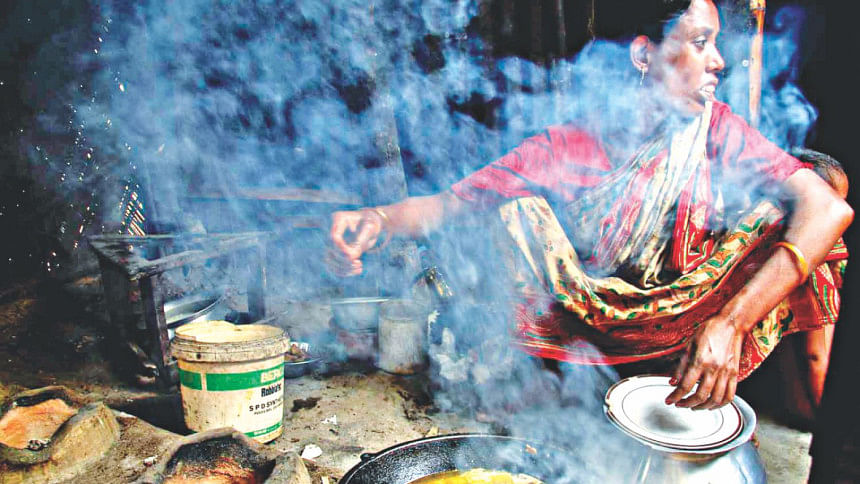Getting serious about ending hunger

In a recent speech delivered at Bangladesh Institute of Bank Management, eminent economist Professor Azizur Rahman Khan said, "In the 21st century a much larger proportion of aggregate material progress has taken place in what our generation knew as the developing world. This growth has been multidimensional: income per person; increase in life expectancy, health and literacy; and reduction in the proportion of those who are in extreme poverty and destitution" (The Daily Star, March 5). Professor AR Khan left out hunger and food insecurity from his list, and this could have been just an oversight. Nonetheless, hunger and food insecurity are still haunting millions in this country, and probably another billion around the globe. UN's Sustainable Development Agenda lists hunger as Goal Two and the target is to "End hunger, achieve food security and improved nutrition, and promote sustainable agriculture," by 2030. Are we really ready to end hunger in Bangladesh by 2030, and if we succeed, how would we know?
Some of my readers might ask: Why bring up this issue once again since it has always been an implicit goal of the development plans and governmental efforts? Because, we have not been getting the bang for our buck. We cannot sit comfortably and gloat about our middle-income status if millions of the hard-working people, particularly their children, go hungry for days on end. Since our PM has reiterated our commitment to the SDG targets, we also need to ensure that we measure these goals reliably and consistently.
According to a publication by the International Food Policy Research Institute (IFPRI) in 2011, "fifty million people in Bangladesh still live in extreme poverty, and 36 million are chronically hungry or malnourished." Since then, we graduated to lower-middle income status in 2015, and the Prime Minister has recently renewed her determination to attain middle-income status by 2021. As we rush to achieve this goal, are we turning a blind eye to some dark spots on our record? According to a recent research study published in South East Asia Journal of Public Health, "The prevalence of under-five child malnutrition in Bangladesh is nearly 40 percent, which is one of the world's highest." Admittedly the two cases I cite are based on old data, but there are other indications that progress on elimination of hunger and malnutrition has been very slow. Last year, the World Food Programme (WFP) reported 40 million people—one quarter of the population—remain food insecure, and 11 million suffer from acute hunger. The 2017 Global Hunger Index (GHI) ranks Bangladesh in 88th position out of 119 countries. While this represents an improvement over the previous year's ranking, we still have an awful lot of hungry mouths to feed and malnourished children to take care of.
As we march towards the seventeen goals of SDG, we must pay special attention to the projects and programmes that address hunger and food insecurity. Whether we need to open gruel kitchens, offer cash/kind directly to the hungry, or create more jobs for the needy, it is not too much to ask, "How many meals will this project provide?" or "How will it affect the food insecurity in this area?"
Let us take a closer look at SDG 2, which commits us to end hunger and ensure access for all people, in particular the poor and people in vulnerable situations including infants, to safe, nutritious and sufficient food all year round. Our success will depend on our ability to track and assess the various indicators and metrics for these goals. In "Data Gap Analysis of SDGs" (DGA), a self-assessment published by the Planning Commission last year, the government has identified critical shortcomings in our data collections efforts in 9 out of 14 indicators to measure hunger and food insecurity. According to DGA we have serious deficiencies in measuring prevalence of undernourishment (Goal 2.1.1) and prevalence of moderate or severe food insecurity in the population, based on the Food Insecurity Experience Scale (Goal 2.1.2). In the rest of this opinion piece, I will focus on the prevalence of food insecurity since, in my opinion, it pertains directly to hunger.
These findings of DGA appear to be at odds with another study, "Voluntary National Review" (VNR) published last summer by the SDG Implementation Committee. According to VNR, "One of the biggest successes of the Bangladesh agriculture sector has been achieving food security for 160 million people in the country." It then goes on to provide a list of achievements which has allowed us to achieve food security including "efficient food delivery mechanism, improved rural infrastructure, liberalised agricultural inputs, and integration of product markets." As we know, this optimistic view of the elimination of hunger and food insecurity is based on the premise that if there is enough supply of food across the country, demand will be there and all of us will have food on our table. Recently, several UN agencies including FAO have disputed this approach based on the premise that supply creates its demand. As Amartya Sen and subsequently others have shown many years ago, availability of food is not equivalent to access to food or "effective demand" as economists call it.
Experts at the UN Statistical Commission have recommended that to measure hunger, the currently popular "prevalence of undernourishment" (PoU) statistics need to be supplemented by Food Insecurity Experience Scale (FIES). For PoU, national reports calculate the percentage of households for which the average per capita daily dietary energy consumption is found to be below thresholds based on daily Recommended Dietary Intake, usually set at 2,100.00 kcal. FIES, in contrast, is based on a survey where the questions refer to the experiences of the individual respondent or of the respondent's household as a whole. The questions focus on self-reported food-related behaviours and experiences associated with increasing difficulties in accessing food due to resource constraints. Research conducted in 1980s by Cornell University found that people experiencing moderate levels of food insecurity will typically eat low quality diets and might have been forced, at times during the year, to also reduce the quantity of food they would normally eat, while those experiencing severe levels would have gone for entire days without eating, due to lack of money or other resources to obtain food.
Thus, a typical household survey to calculate FIES asks respondents eight "yes/no" questions:
"During the last 12 months, was there a time when, because of lack of money or other resources:
1) You were worried you would not have enough food to eat?
2) You were unable to eat healthy and nutritious food?
3) You ate only a few kinds of foods?
4) You had to skip a meal?
5) You ate less than you thought you should?
6) Your household ran out of food?
7) You were hungry but did not eat?
8) You went without eating for a whole day?"
An added feature of the food insecurity scale calculated from these responses is, it provides reliable estimates to identify vulnerable population groups and actionable information that our policy-makers can use to guide policy interventions.
Dr Abdullah Shibli is an economist and a Senior Research Fellow at the International Sustainable Development Institute (ISDI), a think tank based in Boston, USA.

 For all latest news, follow The Daily Star's Google News channel.
For all latest news, follow The Daily Star's Google News channel. 



Comments